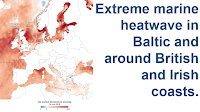Thousands of people have been forced to flee their homes, and at least one person has died, in flooding which has affected much of southern Norway. The country received about three times as much rainfall as would usually be expected in the month of July, with no sign of a let-up in the first part of August. Many rivers have burst their banks, and a series of landslides have been triggered as sediments became waterlogged, impacting transport networks and other infrastructure. Landslides are a common problem after severe weather events, as excess pore water pressure can overcome cohesion in soil and sediments, allowing them to flow like liquids. Approximately 90% of all landslides are caused by heavy rainfall. On Wednesday 9 August the Braskereidfoss Hydroelectric Dam on the Glomma River partially collapsed under the weight of water that had built up behind it, sending floodwaters across the border into Sweden. One woman is reported to have died after falling into a flooded stream on Tuesday 8 August.
Summer rainfall in Norway is usually driven by evaporation over the North Sea, leading to rain when westerly winds prevail, and drier spells when the wind blows from the east. However, much of this summer's rain has been driven by the exceptionally high temperatures in the Baltic Sea this July, which have led to higher rates of precipitation, and high levels of rainfall when the wind blows from the east. The average annual rainfall in Norway has risen by 18% in the past century, with much of that increase happening in the past four decades. Should high summer temperatures in the Baltic become a regular feature of a warming climate, then it is likely that Norway, and Scandinavia in general, could shift towards a much wetter climate.
See also...
Follow Sciency Thoughts on Facebook.
Follow Sciency Thoughts on Twitter.








